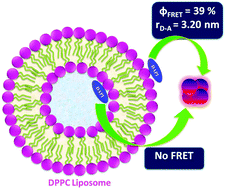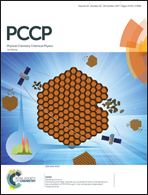Tuning of resonance energy transfer from 4′,6-diamidino-2-phenylindole to an ultrasmall silver nanocluster across the lipid bilayer†
Abstract
Herein we have developed a simple liposome-based donor–acceptor system across the lipid bilayer using 4′,6-diamidino-2-phenylindole (DAPI) as the donor and an ultrasmall ligand-capped silver nanocluster (Ag NC) as the acceptor. The process of Förster resonance energy transfer (FRET) between DAPI and the Ag NC across the liposome bilayer has been demonstrated using steady-state and time-resolved fluorescence spectroscopy. The synthesized Ag NCs with a majority of Ag4 and Ag5 cores have been characterized using FTIR, mass spectrometry, HRTEM, UV-Vis and PL spectroscopy. Scanning electron microscopy (SEM) and dynamic light scattering (DLS) measurements reveal that the synthesized liposomes are small unilamellar vesicles (SUV) with a mean hydrodynamic diameter of 86.91 ± 6.41 nm. By using two distinct synthetic methods, we have been able to identify two selective binding sites of DAPI with liposome namely, the liposome surface and hydrophilic aqueous core. Fluorescence confocal microscopy confirms the location of the donor DAPI within different locations of liposome. It has been observed that the association of DAPI at the surface of liposome results in less efficient energy transfer to Ag NCs compared to that in the bulk aqueous medium. Energy transfer efficiency decreases from a value of 0.76 in bulk aqueous medium to a value of 0.39 for surface-associated DAPI. On the other hand encapsulation of DAPI into the hydrophilic aqueous core of a liposome results in complete inhibition of the FRET process as a consequence of increased separation distance beyond the FRET range. Hence, our study illustrates that the present DAPI–Ag NC pair can be used as a FRET marker to explore various fundamental processes across the cell membrane.



 Please wait while we load your content...
Please wait while we load your content...